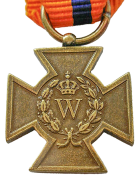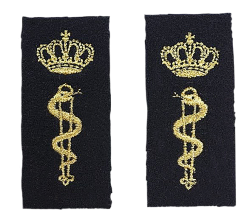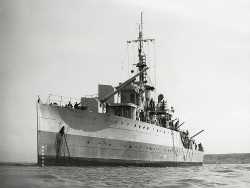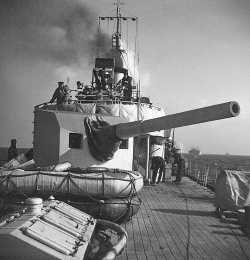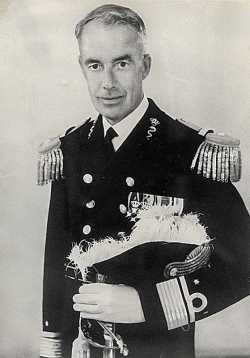This story is in English and In Dutch
My parents married in 1937, he was 31 years old and my mother 26 years old. Because my father was a Navy doctor and was posted to the guard ship in Vlissingen, they went to live there. War broke out in May 1940 and there was hard fighting, Zeeland even capitulated 5 days after the rest of the Netherlands. The citizenry also helped, for example my mother was a volunteer in the hospital and helped roll bandages and spread bread.
Because the situation became increasingly precarious (including a bombardment of Middelburg and Vlissingen), some of the Navy personnel decided to leave via Breskens for Sluis on May 17, 1940. One of those people was my father. It wasn't until May 1945 that my parents saw each other again. Via Oostburg it went to De Panne, where there was enormous chaos and from there to Ostend.
Crossing the Channel
There they were given the opportunity to cross with 2 shrimp boats, but the engines of both vessels showed serious defects. One of the boats turned out to be completely unusable, the other was repaired with the resources available and on May 20 the crossing was attempted with 30 men. The boat was so big that people could take turns sleeping, otherwise it wouldn't fit.
Along the way they came across a lot of wreckage and a German lifebuoy. So ships had been wrecked. On May 23 they entered British territorial waters, quite an achievement without a map. They were literally boat people.
Resistance
In the meantime, my mother had been ordered to leave Vlissingen, she had no economic ties there. In one fell swoop she lost everything: husband, house and income. She returned to The Hague, where she came from, and started working in distribution. From there she joined the resistance...negotiating food parcels for the Red Cross, people in hiding, newspapers, and other resistance work.
Back to active duty
My father (born february 16, 1907) returned to work in the UK and after a while was sent on board the Hr. Ms. Flores posted. The Flores, a gunboat built in 1926, was widely used for the protection of convoys across the Atlantic Ocean. On June 4, 1943, the Flores left for the Mediterranean, where her sister ship the Soemba had already arrived. Both ships were built in such a way that they could sail close to the coast.
Operation Husky
The Soemba and the Flores distinguished themselves by their cold-blooded bombardments on all kinds of targets during Operation Husky, the Allied landings in Sicily. The Allies called the two gunboats the 'Terrible Twins'. On August 5, 1943, things went wrong for the Soemba, during a bombardment on Catania, when a direct hit on the bridge killed the commander Sterkenburg. After the Soemba was used for escort services together with the Flores, both ships provided support during the landings at Anzio and later at Formia in January 1944. In March of that year the ships returned to England to prepare for the Normandy landings.
Warner Albert Borgeld received the Bronze Star for combat actions in the Mediterranean Sea on March 22, 1944 in Portsmouth.
Normandy
The Hr. Ms. Flores was targeted by a German battery near Arromanches. At 05.15 visibility was poor in the Gold sector due to morning mass. Two and a half hours later, when the fog has lifted, the fire can be better positioned and the battery is silenced at 8:24 am. The next day the Flores returns to England for ammunition and fuel and later returns to the Gold sector. On June 12, the Flores will provide support in the Sword sector, where she remained until June 30.
Mr. Ms. From D-Day onwards, Flores was immediately involved in the shelling of German positions in the British sector and on that day alone she fired a large part of her ammunition, mainly on a coastal battery near Arromanches, the Wiederstandsnest 39. She was in a period of returned several times to Portsmouth for two months to load ammunition and, once again, to exchange the guns for those of the Sumatra. The highlight for the Flores came on July 26 when, using aircraft observation, she bombarded gun emplacements at Le Point Homme. Afterwards the air observation post reported that the gunboat's fire had been very accurate with probably four direct hits on the enemy battery.
The Soemba was assigned to the Western Task Force where, together in group 2, she had to provide fire support in the UTAH sector with HMS Hawkins and Enterprise. Under American command, the Soemba fired 140 shells within two hours on June 6 using its 15 cm guns. After half past eight that morning, her deployment for the day was over and the crew could observe the operations on the beaches. In the following days, the Soemba was regularly called into action. On June 12, the Soemba expended her last ammunition and returned to Plymouth for supplies. On June 28, the ship came under English command and released the HMS. Flores off. The Flores replaced her guns between 1 and 6 July with those of the decommissioned cruiser Sumatra. This ship had meanwhile been sunk as 'Gooseberry'. Not only were the guns taken off board, the last ammunition and even canned food (which was 'slightly' out of date, 1927!) was also transferred. Because the guns of the HMS. Soemba had been completely shot out, and no others were available, she returned permanently to England on 11 July, where she was later converted into a radar instruction ship, returning to the Netherlands on 9 May 1946. The HMS. Flores did not return to England until August 7, 1944. Here the ship was laid up in Shadwell Basin until March 29, 1946. On April 1, 1946, the HMS. Flores back in the Netherlands.
Immersed
And as a participant in Operation Overlord, the HMS. Sumatra needs a commendation as she was immersed to serve as a breakwater for the Mulberry harbor.
Tugboats
A perhaps less well-known use of the Dutch and their equipment were the tugboats. No fewer than 12 Dutch tugboats were designated to act as tugs for towing parts of the Mulberry harbor. This happened not only on D-Day itself (and the following days towards Omaha Beach and Arromanches) but also in the months before. One of the designated boats, the Ms 'Roode Zee', was hit by a German torpedo fired by a Schnellboot S 100 (TM boat) near Dungeness during the night of April 23-24, 1944, while towing caisson parts in a convoy. ) and sank. The entire crew died.
Story provided by Borgeld's daughter Sybie Knol
Mijn ouders trouwden in 1937, hij was 31 jaar oud en mijn moeder 26 jaar. Omdat mijn vader Marine arts was en geplaatst was op het wachtschip in Vlissingen, gingen ze daar wonen.
In mei 1940 brak de oorlog uit en er werd hard gevochten, Zeeland capituleerde zelfs 5 dagen na de rest van Nederland. Ook de burgerij hielp mee, zo was mijn moeder vrijwilliger in het ziekenhuis en hielp met verband rollen en brood smeren. Omdat de situatie steeds hachelijker werd (o.a. door een bombardement op Middelburg en Vlissingen) besloot een deel van het Marinepersoneel op 17 mei 1940 te vertrekken via Breskens naar Sluis. Een van die mensen was mijn vader. Het duurde tot mei 1945 voor mijn ouders elkaar weer zagen.
Oversteek naar Engeland
Via Oostburg ging het naar De Panne, waar een enorme chaos heerste en vandaar door naar Oostende. Daar kregen ze de mogelijkheid om met 2 garnalenschuitjes de oversteek te wagen, alleen vertoonden de motoren van beide vaartuigen ernstige gebreken. Eén van de schuitjes bleek echt onbruikbaar, de andere werd met de middelen, die voorhanden waren, gerepareerd en op 20 mei werd de oversteek met 30 man gewaagd. Het schuitje was zo groot dat men bij toerbeurt kon liggen slapen, anders paste het niet.
Onderweg kwamen ze veel wrakhout en een Duitse reddingsboei tegen. Er waren dus schepen vergaan. Op 23 mei kwamen ze in de Britse territoriale wateren, een hele prestatie zonder kaart. Ze waren letterlijk bootvluchtelingen.
Verzetswerk
Inmiddels was mijn moeder gesommeerd Vlissingen te verlaten, ze had er geen economische binding. In één klap was ze alles kwijt: man, huis en inkomen. Zij is teruggegaan naar Den Haag, waar ze vandaan kwam en gaan werken in de distributie. Van daaruit is zij het verzet ingerold…voedselpakketten onderhandelen voor het Rode Kruis, onderduikers, krantjes, dat soort werk
Terug naar actieve dienst
Mijn vader (geboren 16 februari 1907) nam in de VK zijn werk weer op en werd na verloop van tijd aan boord van de Hr. Ms. Flores geplaatst. De Flores, een kanonneerboot gebouwd in 1926, werd veel gebruikt voor de bescherming van de konvooien over de Atlantische Oceaan.
Operatie Husky
Op 4 juni 1943 vertrok de Flores naar de Middellandse Zee, waar haar zusterschip de Soemba al eerder was aangekomen. Beide schepen waren zo gebouwd dat ze dicht onder de kust konden varen. De Soemba en de Flores onderscheidden zich door hun koelbloedige beschietingen op allerlei doelen tijdens Operatie Husky: de geallieerde landingen op Sicilië. De geallieerden noemden de twee kanonneerboten de 'Terrible Twins'. Op 5 augustus 1943 ging het mis voor de Soemba, tijdens een beschieting op Catania, toen een voltreffer op de brug de commandant Sterkenburg doodde. Nadat de Soemba werd ingezet voor escortediensten samen met de Flores, verleenden beide schepen in januari 1944 ondersteuning tijdens de landing bij Anzio en later bij Formia. In maart van dat jaar keerden de schepen terug in Engeland om zich op te maken voor de landingen in Normandië.
Warner Albert Borgeld ontving op 22 maart 1944 in Portsmouth de Bronzen Kruis voor gevechtsacties in de Middellandse Zee.
Normandië
De Hr. Ms. Flores kreeg als doelwit een Duitse batterij nabij Arromanches. Om 05.15 was het zicht slecht in de Gold sector vanwege de ochtendmis. Tweeënhalf uur later, als de mist opgetrokken is, kan het vuur beter geplaatst worden en wordt op 08.24 uur de batterij het zwijgen opgelegd. De volgende dag keert de Flores naar Engeland terug voor munitie en brandstof om later weer plaats te nemen in de Gold sector. Op 12 juni gaat de Flores steun verlenen in de Sword sector, waar ze waar ze bleef tot 30 juni.
Hr. Ms. Flores was vanaf D-Day meteen betrokken bij de beschietingen van Duitse stellingen in de Britse sector en heeft op die dag alleen al een groot deel van haar munitie verschoten, hoofdzakelijk op een kustbatterij bij Arromanches, het Wiederstandsnest 39. Zij is in een periode van twee maanden meerdere malen teruggekeerd naar Portsmouth om munitie te laden en om, nogmaals de kanonnen te wisselen voor die van de Sumatra. Het hoogtepunt voor de Flores kwam op 26 juli toen zij met behulp van de waarneming per vliegtuig, geschutsopstellingen beschoot bij Le Point Homme. Na afloop seinde de luchtobservatie post dat het vuur van de kanonneerboot zeer accuraat geweest was met waarschijnlijk vier directe treffers op de vijandelijke batterij.
De Soemba was ondergebracht in the Western Task Force waar ze samen in groep 2 met de HMS Hawkins en Enterprise vuursteun moest verzorgen in de sector UTAH. Onder Amerikaans bevel verschoot de Soemba via haar 15 cm kanonnen op 6 juni binnen twee uur 140 granaten. Na half negen die morgen zat haar inzet voor die dag erop en kon de bemanning de verrichtingen op de stranden gadeslaan. De dagen erna werd de Soemba regelmatig in actie geroepen. Op 12 juni verschoot de Soemba haar laatste munitie en keerde terug naar Plymouth voor bevoorrading. Op 28 juni kwam het schip onder Engels bevel en loste de Hr.Ms. Flores af. De Flores verving haar kanonnen tussen 1 en 6 juli voor die van de afgedankte kruiser Sumatra. Dit schip was ondertussen als 'Gooseberry' afgezonken. Niet alleen werden de kanonnen van boord gehaald, ook de laatste munitie en zelfs blikvoer (dat 'iets' over de datum was, 1927!) werd overgeladen. Omdat de kanonnen van de Hr.Ms. Soemba geheel uitgeschoten waren, en geen andere voorradig, keerde ze permanent terug in Engeland op 11 juli waar het later omgebouwd werd tot radarinstructieschip, om op 9 mei 1946 terug te keren in Nederland. De Hr.Ms. Flores keerde pas op 7 augustus 1944 terug in Engeland. Hier werd het schip opgelegd in Shadwell Basin tot 29 maart 1946. Op 1 april 1946 keerde de Hr.Ms. Flores terug in Nederland.
Afgezonken
En als deelnemer aan Operation Overlord dient de Hr. Ms. Sumatra genoemd te worden, zij werd afgezonken om als golfbreker te dienen voor de Mulberry haven.
Sleepboten
Een wellicht minder bekende inzet van Nederlanders en hun materieel waren de sleepboten. Niet minder dan 12 Nederlandse sleepboten waren aangewezen om als sleper te fungeren voor het verslepen van onderdelen van de Mulberry haven. Dit gebeurde niet alleen op D-Day zelf (en de dagen daarna richting Omaha Beach en Arromanches) maar ook in de maanden daarvoor. Eén van de aangewezen boten, de Ms 'Roode Zee' werd in de nacht van 23- op 24 april 1944, tijdens het verslepen in konvooi van caissononderdelen, nabij Dungeness getroffen door een Duitse torpedo, afgeschoten door een Schnellboot S 100 (TM-boot) en zonk. De gehele bemanning kwam om.
Verhaal door Sybie Knol, Borgelds dochter.


